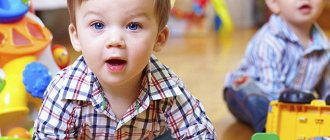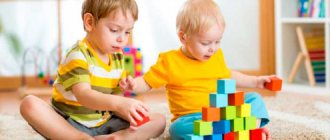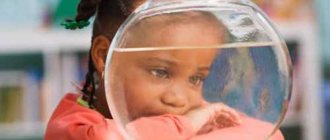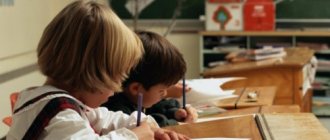A four-year-old child very quickly learns what interests him. He has a well-developed imagination and word creation. He loves to make up stories and tell them. At this age, it is very important not to ruin his nascent creative abilities. Developmental activities for children 4 years old should be as informative and interesting as possible. Parents should be prepared for a wide variety of unexpected questions from their child. We must begin to master the basics of mathematics, grammar and other disciplines. After all, school is coming very soon.
How to organize classes
To teach a child, you do not need to be a teacher with many years of experience. You can do everything yourself no worse than in special classes. Any activity should resemble a game and be fun. Even the most serious subjects are easier to learn through play. Plan your activities for the week ahead. This way you will be able to fully prepare for them, find the necessary materials and decide what you will pay more attention to this time.
Classes must be regular. It is imperative to allocate time for them in the child’s daily routine. It is necessary to develop logic, arithmetic, speech, literacy, creative skills, and outlook. Also, don’t forget about physical exercise. They should be given regular attention. You need to distribute subjects as evenly as possible and study each a little throughout the week. But the child needs to like it. If he doesn't want to study numbers at the time you schedule, try switching to something else.
When creating a lesson plan, remember that children get tired very quickly and cannot study for too long. Therefore, do not try to complete all disciplines in one day. And if your child goes to specialized clubs or sections, then try to consolidate the material covered in class at home.
Development guidelines at 5-6 years old
Developmental activities without a specific goal will not bring success. You need to know what to teach children. For example, at the age of 5 years, a child can cope with the following tasks:
- tell about yourself and your family;
- name the time of year, time of day;
- explain the simplest cause-and-effect relationships (mom does the laundry because...; dad took the umbrella because...);
- explain the purpose of household items (why do you need a table, chair, pan, pen);
- name geometric figures and objects similar in shape to them;
- count several objects going through ten;
- name the colors;
- tell what parts furniture and household items consist of;
- remember and pronounce words and phrases in a foreign language;
- shade the outline drawing; cut strips of paper with scissors and make a rug out of them; copy the pattern.
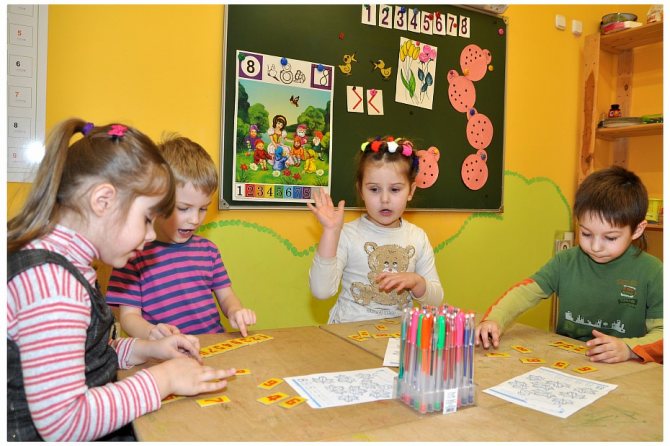
At 6 years old, children can do more complex actions:
- understanding the plot connection of pictures and composing a story;
- explanation of the meaning of simple proverbs;
- performing basic arithmetic operations;
- generalization and division into groups;
- explanation of the meaning of the word (actions, signs, concrete objects and abstract concepts);
- drawing up the rules of the game;
- orientation in space and time;
- drawing a person, copying patterns and geometric shapes;
- performing game exercises, repetition and composing simple dialogues in English.
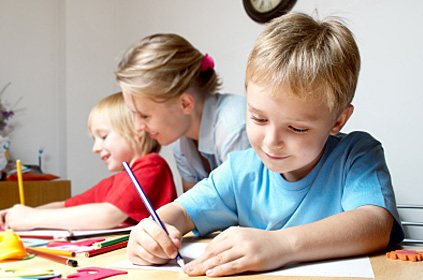
Skills at 6 years old depend on the amount of homework and kindergarten attendance
Special home study opportunities
Educational activities with your child at home have many advantages.
A flexible schedule allows you to take into account children’s temperament, speed of perception and thinking, and character traits. During classes at home, various “rituals” (poems, songs, special words, fun warm-ups) are easily invented and performed, setting the child up to start or complete work.
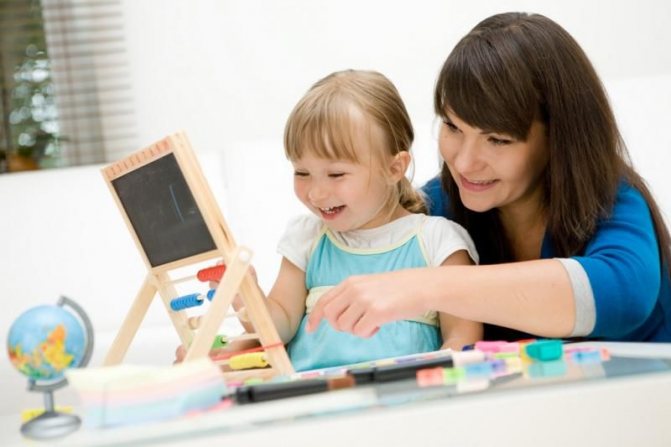
Home classes are very convenient
At home, you always have the necessary supplies at hand. During the lesson you may need not only paper and pencils, but also construction sets, cubes, and toys for role-playing games.
Even furniture is quickly turning into a piece of educational equipment. And if a child is learning English, then during the lesson the necessary cards with letters and words are quickly prepared. This will help parents teach their child to read English and prepare them to master written language.
Practical tasks for children 4–5 years old
Parents should help their child consolidate and deepen existing knowledge. Tasks for children need to be constantly made more difficult. Over the course of a year, the child must learn to correctly use prepositions, count to ten, distinguish between right and left sides, what is more/little, more/less, and draw a line with a pencil without lifting the pencil. If your baby has learned this before, then don’t stop and move on. Otherwise, the child will no longer find it interesting to study.
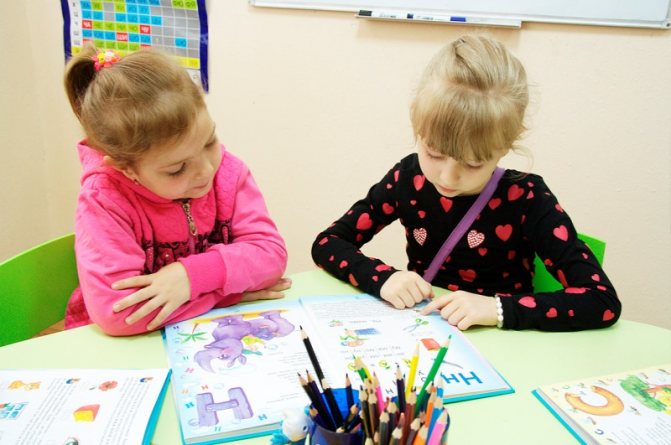
Tutorials and examples
The practical lessons themselves can be carried out using already prepared manuals and examples for boys and girls.
This could be some kind of visual materials, stickers, tasks for the development of logic, writing and speech.
All this can be taken from a ready-made one. This will simplify the entire learning process.
Reading and writing
If your goal is to teach your child to read and write before school, then use a special primer for preschoolers. It has everything you need to teach your baby to put letters into syllables, and syllables into words. You can not limit yourself only to these developmental activities for children 4–5 years old, but play special games. For example, guess a letter for your child, and let him find it in the primer and point to all the objects that begin with it. This will help him learn to highlight the first syllable in words.
Then you can do it at speed. And after some time, the task can be complicated by searching for several letters at the end of words. Another option for the game: stick up pieces of paper with the initial letters of different objects around the house so that the child remembers. And then you can complicate the task and glue the letters incorrectly so that the child looks for mistakes.
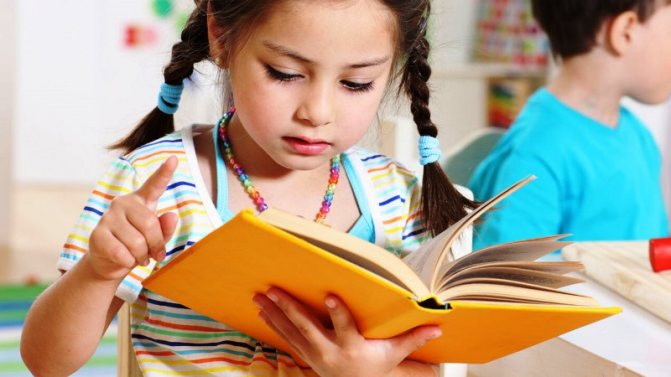
Cards and visual aids
For any discipline, it is recommended to use special educational cards that depict interesting pictures or tasks. For example, they are very useful in studying sides. You can find a colorful or funny drawing that clearly shows where the right side is and where the left side is.
And numbers and the ability to count can be reinforced with the help of coloring books, on which you first need to connect the dots in order. This will be very interesting for the child, because he will be curious about what kind of image is encrypted there. Story pictures will be useful for speech development. For example, take a drawing, show it to your child and ask him to write a story. To make it more complete, ask leading questions. Paired cards are useful for developing logic. These are, for example, games in which you need to find for one image another associated with it: a shoe for a foot, a glove for a hand, and so on.
Activities for children aged 4 years using benefits
It is better to buy all manuals, books and notebooks in bookstores, rather than download them from the Internet and print them on a home printer. You won’t find material of decent quality on the Internet, and when printed on a home printer, it will deteriorate even more - you can’t offer this to children, you risk ruining all the fun of the lesson. But even in a bookstore, you need to choose with special care, so that the book is compiled by progressive specialists, the tasks are clear and interesting to the child, and the pictures awaken additional interest in the lessons.
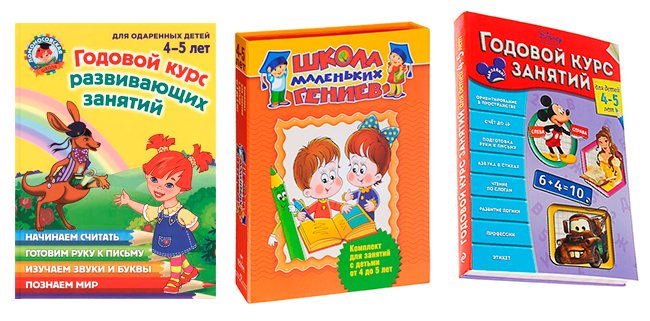
- The manual “Annual course of developmental activities (for gifted children 4-5 years old)” includes a full annual course of developmental activities for children 4-5 years old in the main areas of preschool education: literacy, mathematics, preparing the hand for writing, getting to know the outside world, development of speech, logic, attention, imagination.
- Set of 7 manuals “School of Little Geniuses. For 4-5 years old" is a comprehensive program of classes that covers all areas of child development and education and complies with the Federal State Standard for Preschool Education. Each kit contains methodological material to prepare a child for school and general development. Each book contains entertaining educational tasks, exercises and games.
- Manual “Annual course of studies. For children 4-5 years old" contains the main topics of preschool education, with pictures of the child's favorite multiplex characters.
Recommendations for choosing a benefit
What to look for when choosing developmental aids, books, workbooks with tasks for children 4 years old:
- Almost all manuals with tasks are designed for a certain age and it is indicated on the cover - select by age.
- Activities for children for 4 years old must correspond not only to their age, but also to their abilities - the child must solve all the tasks assigned to him without making excessive efforts, otherwise he will need to move on to easier tasks, and there is nothing wrong with that. This way you will maintain your child’s interest in classes without discouraging the desire to learn.
- Choose professional authors who compile manuals; usually their experience and qualifications are described in the manual itself - the author must have a specialty and considerable experience in teaching preschoolers.
- Choose manuals with high-quality illustrations - this is very important for children. Illustrations should be: colored in calm colors, consistent with the original objects, without excessive brightness; aesthetic, kind and sweet; understandable for a 4-year-old child, with the basic features of identifying objects (the hare should look like a hare); depict adequate emotions, gestures and movements; images must correspond to the text and be consistent; There should be air around the images (white background) for better perception.
All these recommendations are met by manuals from KUMON (the world's largest children's additional education center), which contain high-quality illustrations and assignments compiled by highly qualified specialists.

- Manual “Logic and Thinking”
- The manual “Getting ready for school. Learning numbers and shapes. For children 4-5 years old"
- The manual “Magic labyrinths. For children 4-6 years old"
- “Learning to tell time. An hour and half an hour. For children 3-5 years old"
- And other benefits from the KUMON training center"
How to study with benefits
Classes on manuals, at the initial stage, should take 15–20 minutes. A four-year-old child is not able to sit for more than this time, and you should not force him. Choose those tasks from the manual that the child is more likely to be interested in, unless a clear sequence of tasks is recommended. Don’t forget that it is important to do everything with pleasure, praise your child for completing a task correctly, and not scold him if something doesn’t work out. Remember that these rules are important, especially if you want your child to study well and with interest in the future.
The manuals contain activities for children aged 4 years:
- on the development of logic and thinking;
- attention and memory training;
- imagination and creative skills;
- training fine motor skills of the hands;
- literacy tasks;
- arithmetic tasks;
- tasks for speech development;
- introducing the child to ideas about the world around him.
There are manuals for each of the areas separately, and there are those that contain all the necessary categories, which is quite convenient.
Types of child development
Child development can be:
- Physical.
- Mental.
- Emotional.
- Sensory.
- Musical.
- Rechevym.
- Cognitive.
- Tasks for attention.
- Fine motor skills tasks.
- Mathematical.
- Creative.
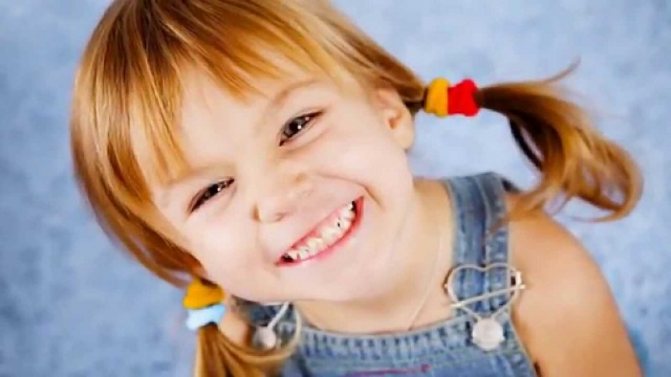
Enough time should be given to each of these types of development over the course of one week so that the child is diversified. Don't forget or ignore any of them. Although, if the baby doesn’t like something, try switching to other tasks. And later you will return to what the baby did not like, but with different tasks.
Types of games that develop logic for children 4-5 years old
Games that develop logic can be divided into several groups. This:
- Didactic games. In other words, these are board-print games. They include tasks to find matches, pairs, and group objects according to a common characteristic. This includes puzzles, sets for composing sequences, and graphic games.
- Educational games. Those games that become more complex over time, that is, after the child has mastered the first levels.
- Speech games. They influence the development of speech, the logical construction of sentences, stories, stories.
The division into groups of games is very arbitrary, because many properties overlap with each other. Thus, the ability to synthesize information is trained equally well when creating a house from cardboard parts, and when assembling a puzzle.
Fascinating mathematics for preschoolers will help you prepare your child for school in a playful way. Develop your child's fine motor skills with modeling. Make a horse with it. How to do this is described here.
Graphic games to develop logic
First of all, such games are aimed at developing logic in a child; in addition, most of them prepare the hand for writing. These tasks are attractive because they are completed without unnecessary details and colors; this does not distract from the game.
There are many types of graphic games:
- labyrinths - the task is to draw a line from point A to point B, from a squirrel to nuts, from a mole to a mink, etc.;
- trace along the line - you need to draw a pencil along the line, resulting in a picture, a figure;
- tasks to find differences between objects, pictures;
- “ complete ” – where you need to complete the missing parts;
- other tasks performed in a simple graphic form.
We offer you several graphic games. Print out the games and offer them to your child. Perhaps some of the tasks will seem difficult - then it is better to postpone them. Remember - there is no need to rush the child, everything should go as usual.
[Slide show]
Physical
A four-year-old baby needs a lot of movement. While practicing with your child, practice agility, coordination and endurance skills. To do this, offer your child gymnastics, dancing, swimming, cycling and other physical exercises. Don't forget to also just play outdoor games. For example, if you choose gymnastics, then it is advisable to spend about 20 minutes on it several times a week. It's better to do this during the day and not before bed.
It's better if these are group classes. This way the baby will strive to keep up with others, and it will be much more fun for him.
Where to start learning to count
At the first stage of learning mental arithmetic, it is necessary to teach the child to count within ten. We need to help him firmly remember the results of all variants of adding and subtracting numbers within ten, just as we adults remember them.
At the second stage of education, preschoolers master the basic methods of adding and subtracting two-digit numbers in their heads. The main thing now is not the automatic retrieval of ready-made solutions from memory, but the understanding and memorization of addition and subtraction methods in subsequent tens.
Both at the first and second stages, learning mental arithmetic occurs using elements of play and competition. With the help of educational games built in a certain sequence, not formal memorization is achieved, but conscious memorization using the child’s visual and tactile memory, followed by consolidation in memory of each learned step.
Why do I teach mental arithmetic? Because only mental arithmetic develops the child’s memory, intelligence and what we call ingenuity. And this is exactly what he will need in his subsequent adult life. And writing “examples” with long thinking and calculating the answer on the fingers of a preschooler does nothing but harm, because discourages you from thinking quickly. He will solve examples later, at school, practicing the accuracy of the design. And intelligence must be developed at an early age, which is facilitated by mental calculation.
Even before starting to teach a child addition and subtraction, parents should teach him to count objects in pictures and in reality, count steps on a ladder, steps while walking. By the beginning of learning mental counting, a child should be able to count at least five toys, fish, birds, or ladybugs and at the same time master the concepts of “more” and “less.” But all these various objects and creatures should not be used in the future for teaching addition and subtraction. Learning mental arithmetic should begin with addition and subtraction of the same homogeneous objects, forming a certain configuration for each number. This will allow the child to use the visual and tactile memory when memorizing the results of addition and subtraction in whole number groups (see video file 056). As a tool for teaching mental counting, I used a set of small counting cubes in a counting box (detailed description below). And children will return to fish, birds, dolls, ladybugs and other objects and creatures later, when solving arithmetic problems. But by this time, adding and subtracting any numbers in the mind will no longer be difficult for them.
For ease of presentation, I divided the first stage of training (counting within the first ten) into 40 lessons, and the second stage of training (counting within the next tens) into another 10-15 lessons. Don't be intimidated by the large number of lessons. The breakdown of the entire training course into lessons is approximate; with prepared children, I sometimes go through 2-3 lessons in one lesson, and it is quite possible that your child will not need so many lessons. In addition, these classes can be called lessons only conditionally, because each lasts only 10-20 minutes. They can also be combined with reading lessons. It is advisable to study twice a week, and it is enough to spend 5-7 minutes on homework on other days. Not every child needs the very first lesson; it is designed only for children who do not yet know the number 1 and, looking at two objects, cannot say how many there are without first counting with their finger. Their training must begin practically “from scratch.” More prepared children can start immediately from the second, and some - from the third or fourth lesson.
I conduct classes with three children at a time, no more, in order to keep the attention of each of them and not let them get bored. When the level of preparation of children is slightly different, you have to work with them on different tasks one by one, all the time switching from one child to another. At the initial lessons, the presence of parents is desirable so that they understand the essence of the methodology and correctly perform simple and short daily homework with their children. But the parents must be placed so that the children forget about their presence. Parents should not interfere or discipline their children, even if they are naughty or distracted.
Classes with children in mental counting in a small group can begin from approximately the age of three, if they already know how to count objects with their fingers, at least up to five. And with their own child, parents can easily start elementary lessons using this method from the age of two.
Advertising
Mental
The psyche of children develops incredibly quickly. They expand the range of their emotions and become more sensitive to the reactions of adults. Therefore, try to approve all the successes of the preschooler and respect his wishes. This will help him develop a positive self-image. Classes for mental development should include exercises on attention, memory and thinking.
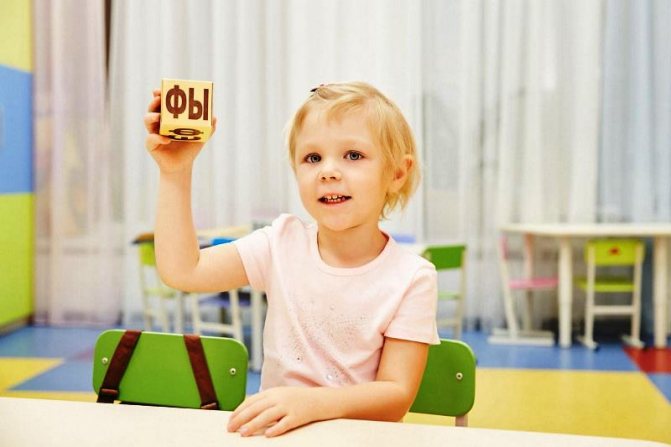
Teach your child to generalize objects according to a certain characteristic, assemble an image from parts, determine the similarities and differences of pictures and toys, select identical objects from a group, repeat a certain sequence of movements, fold a construction set according to a pattern, identify the odd one out, find antonyms for words, memorize the plots of pictures, retell fairy tales, descriptions of events. It is very useful at this age to learn funny rhymes and songs.
What forms of classes are most suitable?
Using toys and various games for developmental learning. The big advantage is that children play and learn at the same time on a completely voluntary basis. They are interested in results and are not overworked. Thus, the development of logic progresses well in Nikitin’s games. Board games gradually teach math, movement rules, letters and reading. During the game, children develop perseverance, patience and skills of decent behavior.
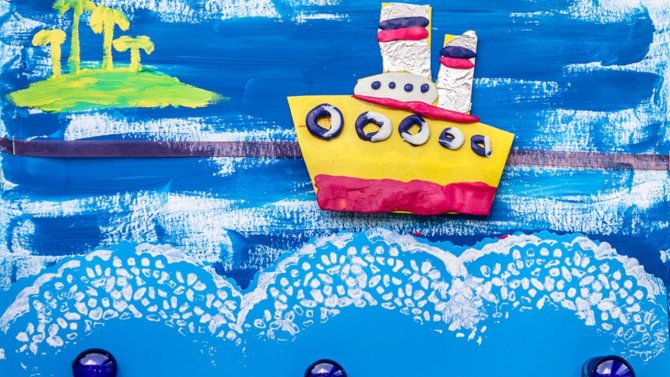
Artistic creativity is a great way to develop abilities
Creativity at this age is best expressed in designing and making crafts. Moreover, the tasks should gradually become more complex, including elements of independent modeling. The child learns to create. He learns to think and think logically, develops fine motor skills.
Developmental learning at 5-6 years old is best accomplished through play activities. The child must, in the process of development, prepare for the traditional school system of education.
Emotional
Emotional development is also important for the baby. At four years old, he begins to understand the relationships between people, can notice changes in the mood of the person who is next to him and learns to express his own emotions. A preschooler already knows how to show empathy and attention. He senses how others treat him.
Communication is fundamental in the development of emotions. Express your emotions. Explain to your child how you feel in different situations. And tell us what different emotions are called and why they may arise. It is desirable that there are no quarrels, anger or discord in the family. The child is too sensitive to this. You can tell instructive tales so that the child understands, using the example of their characters, what to do in different situations, and what is better not to do. Play out scenes with him using toys.
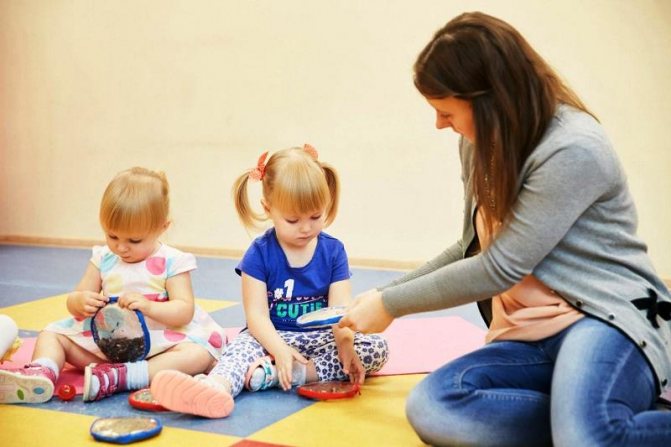
Sensory and musical
Through sensory activities, children improve their sense of hearing, smell and touch. For the development of a 4-year-old child, he should be encouraged to guess objects by touch. This way he will learn about the existence of hard, soft, rough, smooth, warm and cold things. Include smell and taste in activities and games. At four years old, children already know some musical instruments, are familiar with some songs and music of different rhythms. They already have their favorite songs and melodies that they will sing along to and dance to.
Turn on music more often and let your baby dance. Invite him to repeat some movements after you. And also sing together or have karaoke.
Features of the development of logic in children 4-5 years old
Logic at this age undergoes rapid development. Thanks to the enhanced perception of the outside world through the senses, the child begins to compare, analyze, compare what he saw, heard, what he touched, felt.
Basic operations accessible to the logic of a child (4-5 years old):
- comparison - the ability to find similarities and differences in surrounding objects;
- analysis – allows you to isolate certain parts from an object and combine objects into groups;
- synthesis - the ability to recreate an object from its parts;
- classification - the ability to separate objects according to certain characteristics and combine them into groups
Speech
Speech develops in a child at this age at an incredible speed. The biggest influence on him is communication with parents and other children. Thanks to this, the toddler’s vocabulary increases, he learns to construct sentences and express his thoughts in words. Many people at four years old do not yet know how to pronounce sibilants and “r”, so it is worth spending more time practicing the pronunciation of these sounds.
To stimulate your baby’s speech development, teach him songs, rhymes, look at and discuss pictures, reproduce the plot of fairy tales or invent your own, read and discuss stories, listen to audio recordings of fairy tales, make riddles, share your impressions of the past day, practice articulation, study letters and sounds, divide words into syllables.
Divide these exercises into different sessions and practice them constantly. You will see that thanks to them, your child will speak very beautifully and without mistakes. If the child has serious problems with speech, and classes are given to him with great difficulty, it would be useful to see a specialist.
What educational activities for children 4-5 years old are included in the collection?
Since my daughter is often sick, she practically does not go to kindergarten. 3 days in kindergarten and 2-3 weeks at home. At first, I taught the children chaotically, simply printing out various age-appropriate tasks. Subsequently, I began to come up with various themed weeks and develop themed kits. But school is just around the corner. And I had to think about what needs to be taught to a preschooler’s basic skills: writing, reading, mathematics.
And finally I found a solution to the problem: a collection of activities for children 4-5 years old for every day, which can be printed and played, while simultaneously developing in the main areas of preschool education. This collection was developed by leading experts and includes 4 types of tasks:
- Learning numbers and math tasks for children 4-5 years old 11
- Graphic tasks for children 4-5 years old to prepare their hands for writing
- Learning letters and sounds
- Exploring the world around us
See also letter outlines for developing graphomotrics and learning letters
Fine motor skills
Fine motor skills are one of the important points in a child’s development. It helps develop speech and other skills because it strongly interacts with different areas of the brain. Therefore, let your child play with sand, cubes, construction sets, beads, cereals, beans, and so on. Be sure to do finger exercises, teach your little one to tie knots, fasten and unfasten zippers, buttons, buttons and hooks. Draw and sculpt more, make appliqués and create various crafts from natural materials. It is very efficient to transfer and sort different grains.
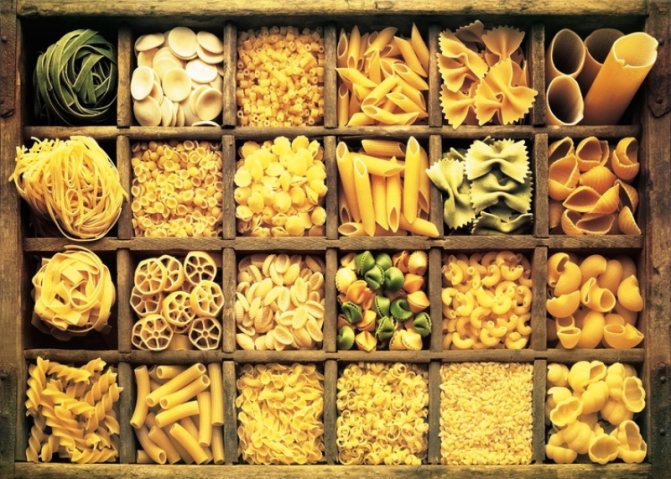
Cognitive
Children at this age are actively exploring the world. And cognitive development should include classes on memory, thinking, logic and attention. At home, you can prepare special thematic cards with pictures and words. For example, you can group them into seasons, land transport, professions, and so on. Group whatever you have enough imagination for.
And in class, show your child pictures and pronounce the words clearly. Tell us about the features of things. Also ask to name the colors and shapes of objects. And then you can complicate the task. For example, you name some things, and the baby must generalize and group them. Study parts of the whole with your child and learn to find what is superfluous.
What parents should know
At the age of five, parents need to evaluate how their baby is developing. It is necessary to trace how the relationship develops between the child and the world around him.
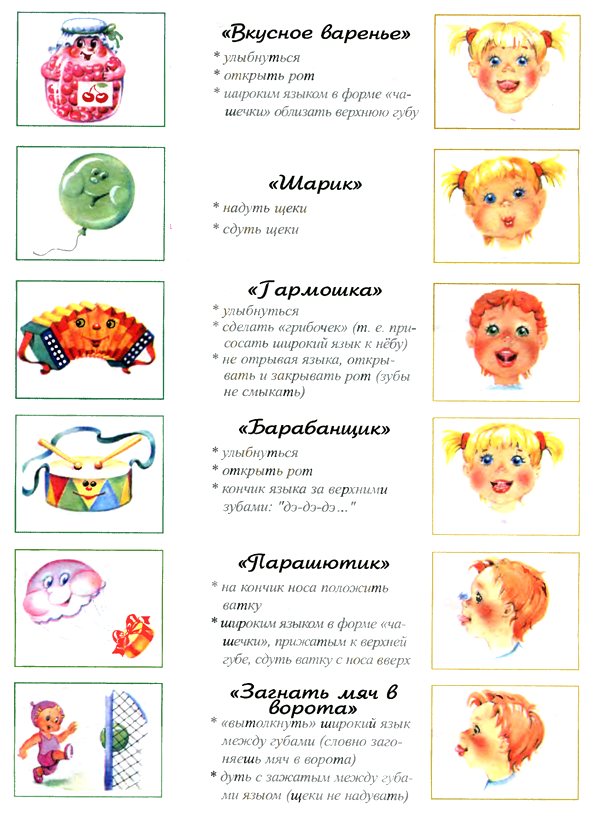
Pronunciation development game
Children should be monitored in the following areas:
- the child’s behavior at home, on the street, in public places;
- communication with people around you;
- what kind of friends children have, understanding and perception of friendships;
- How developed is the children’s speech, does the child have problems with pronunciation, how does he construct sentences.
An important point is comfort and harmony in the family, since preparation for school life must begin with instilling skills such as order and responsibility, which the child learns primarily in the family. Developmental activities, in addition to gaining new knowledge, will help set children up for a correct perception of the world and correct their behavior.
To develop attention
It is important to teach your child to concentrate and notice details. He will really need this at school. In order to teach this to your toddler, ask him to repeat certain actions after you, cross out a certain letter in the text (you can make it more complicated, and cross out one and underline the other), play with him “edible/inedible”, “flying/not flying” . Another interesting game: touch parts of the body and name them, let the baby repeat after you, and then start making mistakes.
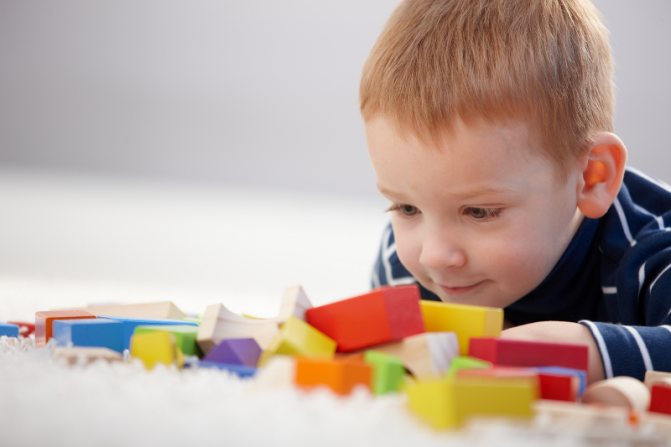
Mathematical
The kid needs mathematics because he is about to go to school and it would be nice for him to already have some kind of foundation before that. Teach your baby numbers, counting and geometry. But, as in previous cases, be sure to turn the learning process into an entertaining game.
Basic Geometry
Learn the basic geometric shapes: circle, diamond, square, rectangle, oval and triangle. First, just show them to your baby, and then ask him to choose the one you named from a number of figures. And later you can complicate the lesson and study their volumetric analogues.
Use images of figures, tables with examples from life, or you can even look for these figures in everyday life and conduct classes on them.
Numbers and numbers
By school, a child should learn to count to at least 10 and write these numbers. This is best done with the help of your baby’s favorite toys, special sticks, various figures or the “I Count It Easy” mathematical dominoes.
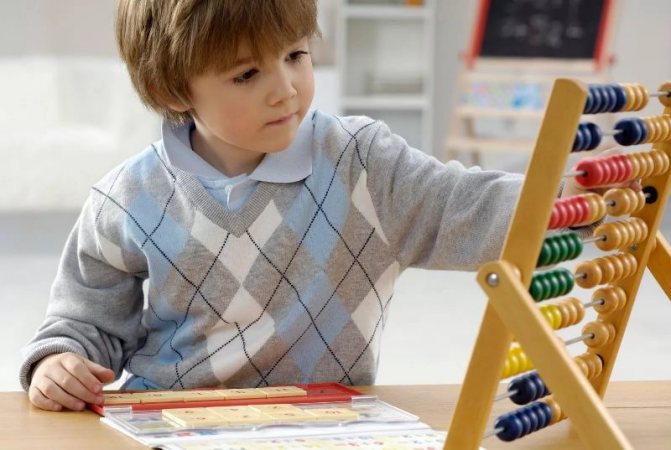
Equalities and inequalities
The child must master the principles of comparing objects: what is more and what is less. He should also learn to add equalities himself. This is also best done with toys. For example, tell your child a fairy tale, get to an important point and ask to divide the characters into equal parts so that they fit into two buses. Your imagination is very important here. Although there are also many ready-made tasks on the Internet that you can find and use in your training.
Logics
Four years is the best age to start developing logic. Encourage your child to find similarities and differences in the images. There are quite a lot of tasks for this, choose the ones you like and work on them. Practice searching for common qualities of one group of objects. For example, dishes. And also in searching for extra items in the group. Another fairly effective exercise is finding errors. The child should be able to find them not only in pictures, but also in words. For example, in the sentence: “In winter I always swim in the lake.”
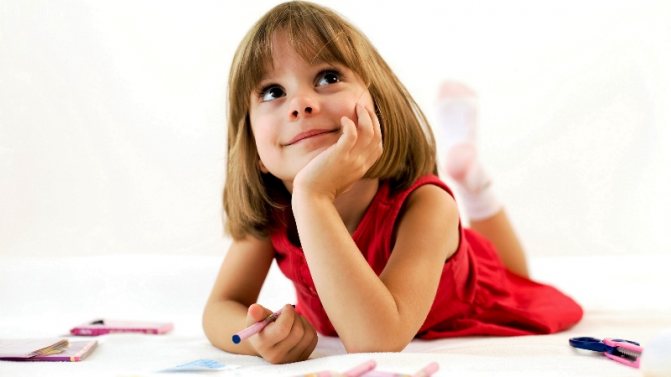
All familiar letters
There will be nothing wrong if adults tell the child what letters are. This will be interesting for 5 year old children. But how to learn them with a child?
Usually girls and boys themselves begin to ask: “What are these badges?” - when someone from the family reads a book to them. There is also a special alphabet for children 5 years old. This colorfully published alphabet is a wonderful book. She is still unfamiliar to the kids. So it's time to buy it right now and start practicing.
The main thing is not to demand that the baby firmly understand everything. It is more important to maintain interest in learning. It is enough to conduct such classes for children 4–5 years old for 10–15 minutes a day. It's good to learn letters with short words. But the form of the game is strictly required!
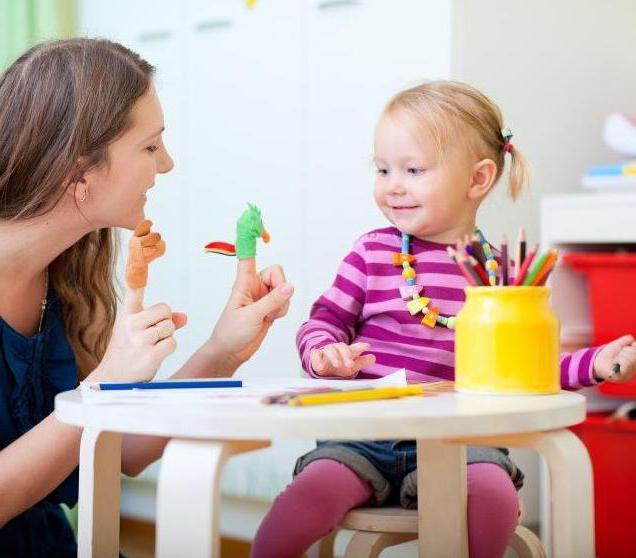
Educational activities for children 4 years old in a playful way
Play is the main form of activity for a child. You just need to include a little training in it. All games can easily be turned into educational games. And almost everything in the toy basket can be turned into educational material.
Constructors
A construction set is one of the most useful toys for development. Take not ordinary sets, but those that include auxiliary items and characters. For example, there are kits with animals or with letters printed on blocks. You can ask your child to come up with new shapes that can be made from blocks, or to imagine what his structure would look like in real life. And if the set includes additional characters, then you can act out scenes and create an entire fictional city. Offer your child your construction plan, drawn on a piece of paper, and let him bring it to life. Or make a labyrinth out of blocks and ask your child to walk through it to you.
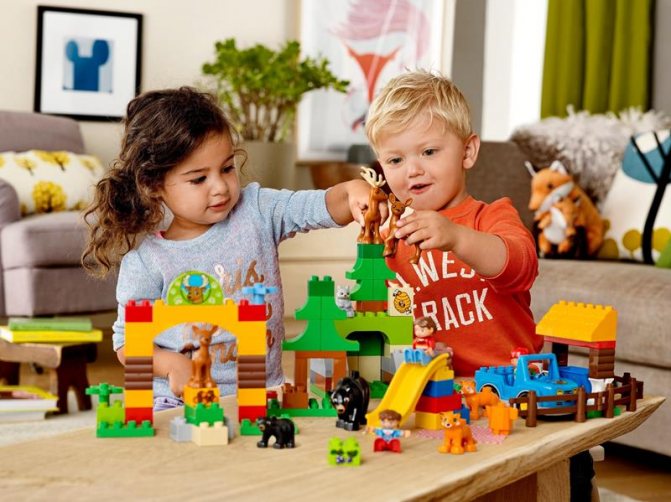
Board games
Board games are very different. Preschoolers can play with puzzles to learn the alphabet, dominoes, various “tricks” or cards. This will be interesting not only for the child, but also for you. Moreover, in this case you do not need to come up with any tasks. The manufacturers have already done everything for you, and you just need to find the time to play them. But this can also be considered their disadvantage at the same time, since you will not be able to come up with anything new other than what is written in the instructions.
Favorite toys
Use any of your baby's toys to develop his skills. For example, if your child loves cars, then stick letters of the alphabet or numbers on them, and on the other side place a parking lot with words that start with these letters or with the same numbers. And let the kid park his cars correctly.
And if your child cannot live without dolls, then give them candies and count them, or solve problems on how many sweets someone has under different conditions. Another wonderful game option is the store. Here you need to count, and subtract, and multiply, and talk with the “buyer”. This game develops many different skills.
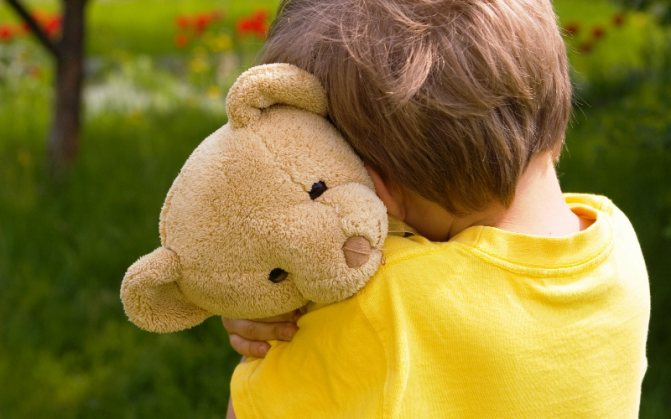
Available materials
Crafts made from scrap materials will greatly help in developing a child’s creative abilities. You can use a wide variety of materials: cereals, household items, paper or special creative kits.
You need to make from them what you are currently studying: numbers or letters. And how to make the craft itself, what to use and what to attach it with – it’s all your imagination.
Paper
At 4 years old, you can safely try to create origami with your child. There are a lot of schemes. Take paper and the simplest versions of origami; your child should enjoy making different animals. You can also create various applications from paper, cardboard and glue. Let him use children's scissors to cut out the elements you drew, and then glue them on. You can decorate educational notebooks with paper products, then the child will like them more. Or even use special stickers for your efforts.
Natural materials
You can make various crafts with your child from what surrounds us all the time. These can be cones, pebbles, twigs, and so on. You can use them to create animals, birds or even little people. And with the help of threads, buttons and paints they can be turned into fairy-tale characters.
Threads and balls
Various ropes can turn into dolls and animals. And you can create beautiful patterns from threads by weaving them and tying them to mesh fabric.
Just give your child the necessary materials, show him the first few movements, and then just watch your baby's enthusiastic work. Sometimes he may need your help, don't refuse. Offer your options for patterns or toys that can be created. Do everything together. And communicate constantly. Add an element of counting, naming letters or numbers to any activity.
Features of the development of thinking in children 4-5 years old
At the age of four to five years, increased development of the right hemisphere begins. This hemisphere is responsible for the synthesis of information, the ability to analyze and compare data.
It is at this age that the prerequisites for successful mastery of mathematics, writing, and reading are laid. The stage of understanding and accepting the surrounding reality begins. It is important to provide the child with the most complete sensory development. These are games that involve as many different materials as possible - both for tactile development and for olfactory, gustatory and visual experience.




